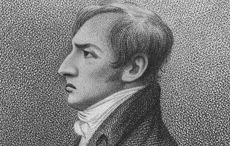Cornelius Ryan passed away on November 23, 1974, and though many who recognize his name think first of America’s titanic battle final against Hitler as penned by an American writer, Ryan was a Dubliner. He was a “Dub” with a keen eye for the big story, in fact. Of course, it helps when there’s a big story actually going on and in the twentieth century, there was none bigger than World War II. Heralded as being at the forefront of the modern age of journalism as literature, Ryan continued scribbling down notes of the battles he witnessed until the end, including his own battle with prostate cancer jotted down for his wife who would transform them into the book “A Private Battle.”
Ryan likely stands atop the list of Irish-born “American” journalists in that he is rarely thought of as being Irish but his passage into the world of journalism took its earliest form at Synge Street Christian Brothers School in the Irish capital.
Ryan was born on June 5, 1920. The date was a sign of things to come as D-Day, the day assigned for the invasion of Normandy in 1944, was actually June 5. It was moved ahead one day at the last moment because of adverse weather.
Ryan’s “Longest Day” would be June 6, a number seared forever into the popular imagination. And made more real again by virtue of Ryan’s famous book, and the 1962 movie it spawned.
Ryan did see the war up close. He crossed the Irish Sea to London in 1940, a moment in time when staying in neutral Dublin might have seemed the wiser option. But the young Ryan had the bit between his teeth and he soon joined the Daily Telegraph as a war correspondent - suffice it to say a job title with a lot of openings at the time.
During the course of the war, Ryan flew on U.S. Army Air Force bombing missions, and after the invasion rolled around Europe with General George Patton’s Third Army. After Germany’s collapse, his work took him to the Pacific theater. Cornelius Ryan saw at first hand what he would later write down in his books.
Ryan made the move to America in 1947 and got a job with TIME magazine, and later with other publications. War and conflict would remain his beat no matter where he took his notepad.
It was on a visit to Normandy in 1949 that the idea for “The Longest Day” took hold. It would be published in 1959 and head straight for the top of the bestseller lists and a Hollywood studio.
Ryan’s dalliance with the movies would not be a one-off affair. His later book, “A Bridge Too Far,” published in 1974, the year of his death, would also make its way to the big screen but “The Longest Day” would remain Ryan’s calling card, both book, and film impressed upon the collective imagination of more than one generation.
In the book, and in the film, one of the early scenes has a young American paratrooper land in the garden of a home in the Normandy village of Ste. Mere Eglise in the night hours before the dawn beach landings. That soldier’s name, but of course, was Murphy. Bob Murphy.
He landed, so the story goes, in the backyard of the village schoolmistress. Murphy, whose own American backyard was in Massachusetts, was attached to the 505th Parachute Infantry Regiment of the 82nd Airborne Division. He was what allied military planners euphemistically dubbed a “pathfinder.”
In reality, he was an 18-year-old kid who was little more than a dangling target for jumpy German soldiers of roughly the same age. Murphy duly went down in numerous accounts as the first identifiable U.S. soldier to hit French soil that night. He himself later took issue with this.
It seems that he lost his ammunition box on the way down and one was found in the garden’s pea patch. Murphy reckoned it was someone else’s ammo box.
Either way, what is fact is that at an age when he should have been getting nervous about girls and little else, Bob Murphy threw himself into a death-dealing unknown and fought his way through the following days with courage, and more than a little Irish luck.
He would later write down his experiences in a book that read like a template for “Band of Brothers,” replete as it was with tales of holding off German panzers with bazookas, and fighting alongside comrades such as Lieutenant John “Red Dog” Dolan and under commanders of the caliber of General James Gavin, known as the “Jumping General,” or “Jumping Jim” because he threw himself out of planes and into combat alongside his men.
Murphy and fellow paratroopers in “A” Company, 505, were not dropped into France just to reach the ground and create random havoc in the German lines. They had a specific mission. In this case, it was to seize and defend a bridge crossing the Merderet River on the road that ran east to west from Ste. Mere Eglise.
The goal of the mission was to prevent the movement of German troops down to the Utah Beach landing zone. The resulting firefight would actually be used as a model for the bridge battle scene in “Saving Private Ryan,” which was largely filmed in Cornelius Ryan’s native land, specifically County Wexford. It would be just one of many missions carried out in those crucial early hours of the longest day, some successfully, some not.
Many veterans of the invasion would later say that the waiting was as nerve wracking as actual combat.
“The Longest Day” was, for sure, preceded by the longest night. The American forces that landed during the night, and hit the beaches at dawn on June 6, 1944, could draw a bead to just about every ethnic group in the Europe they were setting out to liberate.
This was no less the case with Irish Americans, who made up a significant proportion of the U.S. invading force. So we remember the Murphys, Dolans, Gavins and all the rest.
And we remember Cornelius Ryan, who rests today a ways from his birthplace in a cemetery in Ridgefield, Connecticut.
---
This article first appeared in the Irish Echo. For more stories, visit their website here.




Comments